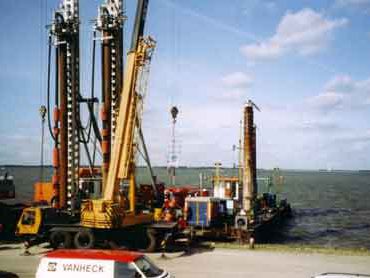Van Heck team player in Ketelmeer test boring
Van Heck BV has proven itself to be an important team player in the Cubic Square test project, which developed an innovative drilling technology. The first tests, subsidised by the Ministry of Economic Affairs, have now been conducted successfully in the Ketel- meer, where Cubic Square collaborated with RWS (Public Works and Water Manage- ment) and its partners Van Oord and Ballast Nedam. Van Heck ensured that tests could be conducted properly on site.
Jeroen van Heck speaks of an ‘interesting project’ in which to participate. Due to the complicated application technology, but certainly also due to the logistics and working conditions. ‘A difficult location to set up your equipment. Not much space to work.’ He is referring to the available space of 11 by 17.5 metres on the pontoon. On it are six pumps as big as sea containers (2 x 400 m³ per hour at 18 bar, 2 x 600 m³ per hour at 10 bar), a significant aggregate plus the engineers required. Van Heck laughs: ‘A matter of creative placement…’ Checked off everything in advance, the preparation took a long time. ‘First of all, everything was drawn out and calculated very precisely. Connecting pipes and lines. That takes quite some thinking through.’
Pumping is an essential part of the new clever drilling technique, where scarce industrial sand is extracted from deeper layers without removing excessive amounts of silt. Cubic Square demonstrated by means of the test that a subsurface bed can be lowered without any environmental problems through subsurface dred- ging. Instead of costly silt removal, experiments are taking place with the multi-jet drill, which is used to pump water into the ground. What determines whether or not these kinds of tests are successful is the water- jet propulsion of the mixture that is to be brought up, and complete control of the water pressure in the cavity that is to be created. Those techniques require a very high level of knowledge of the pumps and it’s capacity. Cause for Van Heck to appear quickly for this job. A worthy mission for good reason. ‘We were invited because they need pumps that always work, and at the correct pressure.’ That sounds easy, but Jeroen van Heck discussed matters long and often with the parties concerned before a single pump was put into place. ‘We contributed ideas from the outset and were involved in the entire process.’
Drilling method
The drilling method will shortly also be used for maintaining flood plains. By only extracting sand, the fertile soil for farmers is left behind. Moreover, the landscape is not affected. ‘This is a good solution for all parties’, considers Jeroen van Heck. He hopes and expects them to work together as project partners more fre- quently in the years to come. ‘We create the basic conditions; by providing decent equipment and correct water pressure they are able to work well.’

